| 

Manhattan’s skyscrapers were not only the playground
of superheroes, but giant beehives of business: headquarters
of global corporations, central offices for far-flung plants
and facilities, the focal points of vast commercial energies.
Their lines of communication and authority spread to the ends
of the planet; with utter confidence, their builders considered
them to be the very center of the modern world. No sooner
have we entered their doors, in fact, than we are presented
with symbolic renditions of the earth itself: an enormous
translucent globe in the 1937 lobby of Top of the Town’s
‘Radio Center’ [below], for example, or a futuristic,
two-story-tall chronometer, ringed by a map of the world and
its twenty-four time zones, which sits in the lobby of the
Manhattan headquarters of Janoth Publications, a Time-Life-type
media empire that is the setting of the 1948 film The Big
Clock. As a tour guide explains to his group, the clock’s
complex mechanism does not simply keep time, but actually
regulates activity throughout Janoth’s global domain.
The symbolism is obvious, of course: the towering device
stands for the skyscraper headquarters just as the skyscraper
itself stands for New York — the ultimate ‘big
clock’, constantly pacing the world and tracking its
progress.
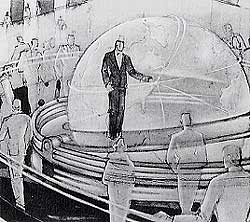
Art department sketch from
Top of the Town (1937) |
|
These
symbolic elements also suggest something else: that
the skyscraper holds an entire world within itself —
a complex microcosm of society whose trajectory is drawn
from the shape of the building. In the movie city, we
regularly follow characters on their ‘way up’,
locating in the tower’s upward thrust a model
for other, less visible kinds of movement. Rarely has
this parallel been presented more bluntly (or amusingly)
than in a racy 1933 film called Baby Face: the audience
follows the career of an ambitious newcomer named Lily
Powers (Barbara Stanwyck) by tracking her physical rise
within the offices of the ‘Gotham Trust.’
After Lily gets her first job by seducing the manager
of the personnel department, the saucy strains of ‘St.
Louis Blues’ start to play as the camera pulls
out of the forty-seventh-floor window, rises two stories
to the filing department, and returns inside. Here Lily
meets another supervisor and makes another conquest.
‘St. Louis Blues’ plays again, and again
the camera pulls out the window, rising this time to
the mortgage department, on fifty-one. And so on, through
the accounting and executive offices, until finally
Lily has reached the very top of the building —
the penthouse of the bank’s handsome young chairman,
George Brent. |
However unorthodox her technique, Lily at least works her
way up one step at a time, her gradual ascent precisely calibrated
by the building’s tier upon tier of windows. Yet in
the classic skyscraper era, lavish architectural efforts were
expended precisely to circumvent this sort of plodding, floor-by-floor
rise; instead, the exteriors of skyscrapers sought to suggest
a single, daring leap, an express track to the sky that would
mask the unglamorous stacking of floors within. It is just
this distinction — between interior and exterior, between
a hardworking climb and a swift, dizzying leap — that
frames Joel and Ethan Coen’s parodic exploration of
the classic New York skyscraper, The Hudsucker Proxy (1994).
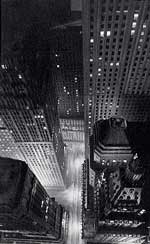
Constructing the New York skyline for The Hudsucker
Proxy (1994). |
|
It
is 1958, and at the center of a mythic Wall Street skyline
rises the headquarters of Hudsucker Industries, an imposing
depression-era tower whose exterior design — like
those of the actual Manhattan buildings it is based
on — seeks to sweep the eye in an unbroken line
from bottom to top [left].
And it is precisely at those two extremes that the story
begins. At the foot of the building, Norville Barnes
(Tim Robbins), a bumbling but ambitious newcomer from
Muncie, Indiana, is arriving for his first day on the
job, ready and eager to work his way up. At the top,
meanwhile the man who built the building — and
the immense corporation within it — has chosen
that very moment to make a dramatic move in the opposite
direction, leaping out of the forty-fifth-floor boardroom
window and plunging to his death. Cinematically elongated
in time and space, the fall of corporation chairman
Waring Hudsucker (Charles Durning) feels not scary or
tragic but oddly exhilarating, as we sail right alongside
the plummeting figure, the vertical lines of the building’s
sleek exterior racing beneath us like railroad track,
the camera angled, for much of the distance, up the
length of the soaring tower — as if to recall,
even at this most terrible of moments, its original
ascendant promise. |
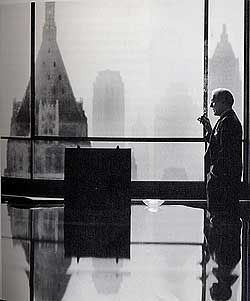
The Hudsucker Proxy (1994). |
Indeed,
within hours, the hapless Norville is making that very
ascent — at a rate only slightly less impressive
than Hudsucker’s fall — when he is elevated
from a lowly position in the building’s inferno-like
mailroom to its airy executive offices, not through
any hard work or intelligence on his part, but as the
unknowing patsy — or ‘proxy’ —
of a boardroom scheme to depress stock values and buy
up the company at a bargain. That these executive offices,
for all their imposing size and high polish, may have
grown a bit too detached from the world below is powerfully
conveyed by a shot of Hudsucker’s successor, Sidney
Mussburger (Paul Newman), silhouetted in the high boardroom
windows. Not only Mussburger — the cynical, grasping
executive who has instigated Norville’s rise —
but Wall Street’s towers themselves are reflected
in the mirror-smooth boardroom table, so as to appear
to float weightlessly, utterly disengaged from everything
else [left]. |
But there is far more to the skyscraper then the airy, detached
realm at its top, as we discover when Norville pulls an idea
out of his pocket — a crude pencil sketch of something
that turns out to be the hula hoop — and, indulged by
Mussburger, is allowed to carry the idea through to execution.
In a succession of rapid shots that, among them, manage to
spoof almost every New York office movie ever made (from The
Apartment to The Crowd to The Big Clock itself), we tour the
divisions that fill the length of the Hudsucker Building:
the design department, the advertising department, the accounting
department — even a proving lab where Norville’s
innocent invention is submitted to explosive testing. But
all of Norville’s good intentions are no match in the
end for Mussburger’s evil designs, and the film’s
climax finds the young man in the sad position of Hudsucker
himself — standing outside the forty-fifth-floor window,
contemplating a fatal plunge. ‘You had a short climb
up, kid,’ Mussburger gloats, ‘but it’s a
long way down.’ For all its layers of irony, The Hudsucker
Proxy ultimately takes us on a surprisingly full and complete
tour of the New York skyscraper, inside and out, revealing
along the way the profound disjunction between the reality
of its interior, whose stratified hierarchy of office floors
might well take a lifetime to surmount, and the seductive
(if potentially treacherous) promise of its exterior —
that the entire length of the building might be negotiated,
one way or the other, in a single, breathtaking leap.

An ambulance races through the city’s streets, rushing
the legendary modern architect Harry Cameron (Henry Hull)
to the hospital. Inside, the great man is flat on his back,
close to death, hardly able to speak — the ideal opportunity,
apparently, for him to deliver a lengthy disquisition on the
buildings he sees through the ambulance window.
‘Skyscrapers,’ he proclaims, as his protégé
Howard Roark (Gary Cooper) draws close, ‘the greatest
structural invention of man! Yet they made them look like
Greek temples, Gothic cathedrals, and mongrels of every ancient
style they could borrow. I told them that the form of a building
was to follow its function! That new materials demand new
forms! That one building can’t borrow pieces of another’s
shape, just as one man can’t borrow another’s
soul!’
Catching sight of a modernist apartment house (actually 240
Central Park South), Cameron brightens briefly. ‘That’s
one of my buildings,’ he says, before relapsing. If
not exactly supernatural, it is indeed a strange world we
have entered — the fervid, peculiarly airless precincts
of the film called The Fountainhead.
Directed by King Vidor and released by Warner’s in 1949,
The Fountainhead closely follows the themes of the best-selling
Ayn Rand novel on which it is based — not surprisingly,
since Rand herself wrote the screenplay. Most everyone knows
the story. Howard Roark, a brilliant modern architect, struggles
to build his bold designs in a compromising world. Rival architect
Peter Keating (Kent Smith) is a timid, conventional designer
who produces neoclassical skyscrapers and at first meets with
great success. But when his career stalls, he implores Roark
to design a housing project called Cortlandt Homes and let
it be submitted under Keating’s name. Roark agrees,
knowing that no project bearing his own signature would be
accepted. When Roark’s radical design is grotesquely
compromised during construction, he dynamites the structures,
reaping widespread public fury. But Roark wins his trial and
is vindicated; by film’s end he is building the tallest
skyscraper in the world.
Intense (and sometimes commercially surreal) subplots of passion
and ambition embroider the film, but at heart Rand sought
to present a parable of ideas, using the battle of architectural
modernism against the older eclectic tradition to exemplify
her philosophical belief in the value of the individual versus
the collective. The year of the film’s release, 1949,
was propitious: the first modern, glass-walled skyscraper,
the United Nations Secretariat building, was just coming out
of the ground, soon to be followed by the first steel-and-glass
commercial office building, Lever House. New York’s
skyline was about to receive its first taste of the new International
Style.
It was a dramatic change. For generations, New York’s
skyscraper architects had pursued their own distinctive course
as they raised up the world’s first and most famous
skyline. For them, the skyscraper’s internal steel frame
was a means rather than an end, something to be freely manipulated
wherever necessary to provide a suitable armature for the
picturesque exterior effects they sought to achieve. They
readily used spires, pinnacles and complex setbacks to shape
their towers into ‘artistic’ compositions, then
clad these structures with ornamented masonry facades that
first drew from classical and Gothic-inspired styles and then,
with the coming of Art Deco in the 1920s, explored their own
decorative motifs.
The design of the new postwar skyscrapers, by contrast, proceeded
from entirely different principles. For modernist architects,
the steel frame beneath the building’s skin was not
just the enabler of its height but the prime generator of
its form. No longer would the steel frame be elaborately shaped
to fit the building’s exterior; now that exterior would
take the form most naturally suggested by the frame itself:
simple, repetitive, boxlike. Nor would buildings be clad in
masonry, or covered with any kind or applied decoration. Now,
sheer flat panels of glass and metal would fill in the frame’s
openings, allowing the internal grid of columns and beams
to become visible on the facade of the building — at
least symbolically. (Fire codes generally disallowed the exposed
use of actual structural elements.) The building’s structure
would become its decoration.
As Cameron’s soliloquy might suggest, The Fountainhead
took sides without apology. In the film, the older eclectic
tradition symbolizes spineless collectivism, while Roark’s
bold modernism embodies Rand’s philosophy of rugged
individualism. We are intended to agree solemnly when Roark
states firmly that ‘a building must be true to its own
idea.’ We are meant to jeer when sinister critic Ellsworth
Toohey (Robert Douglas) attacks Roark’s work at an architects'
meeting by asserting that ‘the conflict of forms is
too great. Can your building stand by the side of his?’
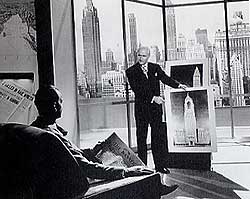
The Fountainhead (1949). |
Indeed,
Rand’s insistent message is conveyed not only
by the dialogue, but through the film’s representations
of its competing architects’ work. Under the direction
of Edward Carere, the Warner’s art department
drew up numerous examples of both Roark and Keating’s
‘projects,’ allowing audiences not only
to hear of their relative merits but also actually to
see for themselves. We see a model of the modern slab
Roark has designed for a New York bank, and stand over
the array of widely spaced slabs he has proposed for
Cortlandt Homes [left].
We also review several renderings of Keating’s
office buildings, presented by the cynical Ellsworth
Toohey [below]. |
The art department did its work well: we instantly grasp
the intended distinction between Keating’s pallid, overrefined
classicism, stretched somewhat absurdly across the face of
thirty-story buildings, and the daringly elegant Modernism
of Roark’s designs. Between these loaded examples and
the film’s tendentious dialogue (painting everyone except
Roark as incompetent, weak, or downright evil) it might be
easy to get swept away by Rand’s polemic. But in almost
every scene, another message keeps intruding, utterly contradicting
the rest of the film.
Rand’s novel had been set in New York, but in the film
the city becomes an active, dominating presence through sweeping
skyline views, placed behind almost every one of the movie’s
interiors. These views are made available to the audience
through enormous walls of glass, each one bigger than the
last, each allowing in a different part of the skyline —
Park Row, Fifth Avenue, or, in one case, a starling composite
view that joins midtown and downtown Manhattan. The thinnest
possible metal mullions, often stretching from floor to ceiling,
frame these vivid cityscapes [below]. A moment’s reflection
reveals something odd about these dramatic window-walls. Nearly
all are in buildings that were not designed by Roark —
buildings that, indeed, predate his rise. Isn’t this
strange? Shouldn’t we have merely glimpsed the skyline
through conventional, smallish windows, until we saw it spread
out, spectacularly, in the first of Roark’s daring modern
interiors? Yet every room in the film, the entire ‘world’
in which Roark exists, seems already to have this light and
airy architecture in place.
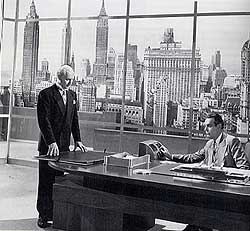
The Fountainhead (1949). |
In
fact, another priority was at work. The big windows
have one overriding purpose: to make the skyline of
New York a powerful, near-constant force throughout
the film. By allowing the skyline to frame, quite literally,
the film’s debate about architecture, the filmmakers
were likely answering a concern voiced aloud in the
movie itself when — in response to the notion
that a Roark project might make a good subject for a
tabloid exposé — a harried city desk editor
wails ‘Oh, who cares about a building?’
Warner’s executives may well have had a similar
fear, that the popular audience would not easily connect
with the film’s ‘highbrow’ debate
about architectural styles: Hollywood movies, after
all, are hardly known for drawing their storylines from
obscure aesthetic controversies. |
If architecture was an esoteric topic, however, the New York
skyline was not. Film audiences everywhere knew it, connected
with it — in no small part, of course, thanks to the
movies themselves. So the presence of the skyline in almost
every frame of The Fountainhead was likely prompted by a similar
connection. ‘Pay attention to this debate about architecture,’
the producers were saying in effect to the audience, ‘because
architecture shapes this skyline that you know so well.’
The skyline became the popular passport into what might be
considered an elitist subject.
But there was a price. The sustained prominence of the skyline,
even in the background, worked to subtly subvert the film’s
intended message. Seen as renderings, one by one, Keating’s
classical office towers do seem insipid and perhaps ridiculous
— the ‘big marble bromides’ that one character
calls them. But that skyline out there, made up of buildings
not at all dissimilar to Keating’s, is something else
entirely. It is dramatic, exciting, bursting with energy —
as no one knew better, obviously, than the filmmakers themselves,
who used it shamelessly to capture and hold the public’s
attention. Roark’s modern skyscrapers, meanwhile, undergo
a transformation just as profound, but in reverse: while his
solitary Manhattan bank tower is convincingly sleek and daring,
his plan for the multibuilding Cortlandt Homes appears to
be the drab, single-minded work of a dull student. The scheme
evinces no notion of a ‘city’ beyond the repetitive
placement of identical buildings; it offers no means of varying
the mix nor composing the group to achieve any sense of vitality
or energy.
We are left with a paradox that has troubled observers of
the city for more than half a century — and that still
remains largely unanswered. Even the most elegant or dynamic
of modern skyscrapers have tended to remain wrapped in a kind
of urban solipsism, focused on their own ‘integrity’
at the expense of all else. Obsessed with being ‘true
to their own idea,’ they speak most significantly to
those relatively few observers — critics and historians
of architecture, as well as architects themselves —
who are inclined to view each skyscraper as an individual
work of art, and who, furthermore, consider the skyscraper’s
status as ‘the greatest invention of man’ to be
its extremely important aesthetic fact as well. Yet as The
Fountainhead itself implicitly admits, most everybody else
sees things quite differently. The film’s high-flown
arguments for the skyscraper as a singular work of art, an
object whose form is determined first and last by its structure,
were entirely undercut by the producers’ shrewd and
knowing recognition that, in fact, the public was devoted
to a skyline built on entirely contrary principles, a skyline
in which any single structure was but one piece of something
larger, its shape to be freely manipulated to contribute,
scenographically, to the overall ensemble. As The Fountainhead
made clear almost despite itself — what was perhaps
banal or absurd in the single electric building could somehow
become dramatic or alive when joined with its neighbours.
Before our eyes, The Fountainhead reasserts the powerful transformation
that takes place when the frame of architectural reference
shifts from the unit to the group, from the one to the many
— a strange and potent alchemy that has proved the puzzlement,
and the bane, of the modern city.
|